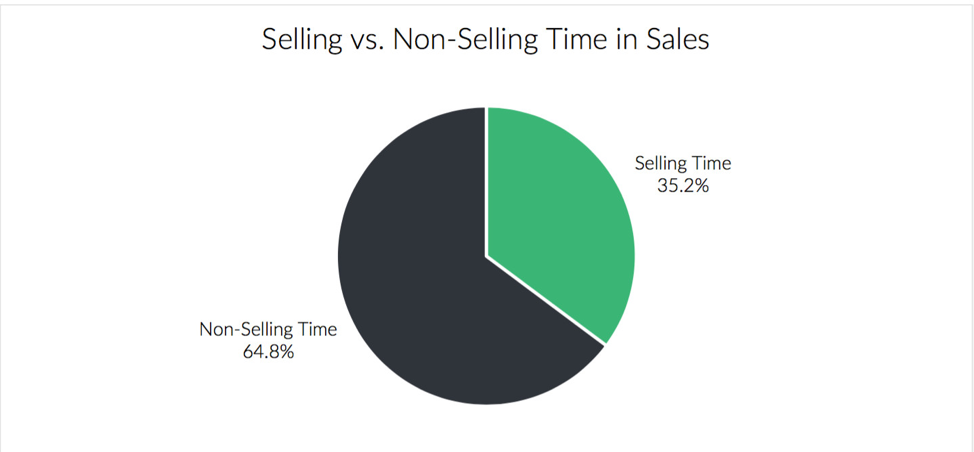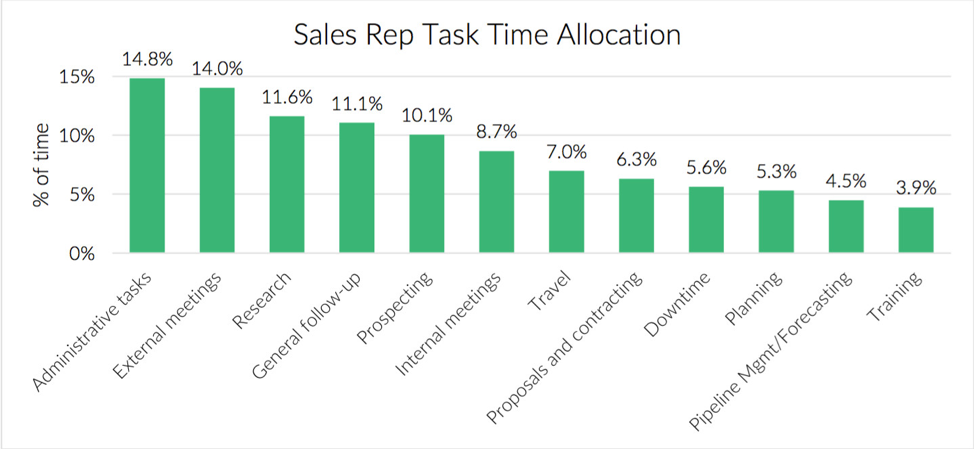
Research shows that sales people only spend about a third of their time selling–yup, just 35% of their time actually selling.
What would be possible if sales people spent two-thirds of their time selling? I think it’s possible to imagine they would sell twice as much.
Where does this time go? And how can we help sales people get selling time back so they sell more? This post is about that.

Source: Why Sales Reps Spend So Little Time Selling, Xant
Where does the time go?
So where does sales people time go? In 2018 Xant conducted some research on this topic and came up with the results below.

Source: Why Sales Reps Spend So Little Time Selling, Xant
1. Admin tasks
The top category that sales people spend their time in is “admin tasks”. “Admin tasks” are a little undefined in the Xant study but we know from other studies that one of the main items in this category is updating and working in the CRM.
Clearly many companies still have CRM setups that challenge their sales people and require sales people to spend a bunch of time inputting and cleaning data. Sales people often complain that their CRM takes too much time to update without helping make further the sales process. CRMs still have opportunity to improve so that they require less babysitting for what they give back.
From other studies we also know that responding to emails from colleagues soak up plenty of time. If a sales person is not in their CRM, you will likely find them living in their inbox. Email can be a big time suck for most categories of employees (A 2018 survey by Adobe of over 1,000 office workers in the USA found they spent an average of 3.1 hours a day on work email, plus 2.5 hours per weekday on personal email.)
There’s also research to show that the “switching time” to go from something like answering an email to something like prospecting can be as much as 23 minutes, so every email alert that pops up and pulls a sales person away from a critical area such as prospecting can a huge time suck.
2. External meetings
For field reps like AEs external meetings are the next highest use of time (this research was conducted pre-COVID). I’m lumping the “travel” category in the graph above into into this category too, so I see two big time sucks here. One is travel to and from external meetings and the other is meeting prep.
For anyone that has travel into a major city like I have from New Jersey to New York, the fact that traveling to meetings takes a lot of time is no surprise. My friends Google Maps and Waze are optimistic fellows. The one hour that the app says for travel easily becomes two and half hours with traffic and all the ancillary travel to get to a prospect’s conference room. There’s also switching time once you get back to the office before you are productive on new tasks. All in, one meeting in the city from the suburbs is more than half a day.
If a meeting is really important enough to spend half a selling day plus on then it’s worth preparing for. My rough rule of thumb is to spend about the same time preparing as the length of the meeting. For a meeting as described above I would likely allocate one to three hours of preparation. Items to consider researching can include the prospect’s Linkedin profile, social media posts, website, any company earnings calls or financial fillings.
3. Research
In today’s highly competitive sales environment, sales people are having to research their prospects not only to prepare for sales meeting but also to have a reasonable chance of having a conversation or meeting in the first place. Therefore, it’s no surprise to see the third use of time is research.
An issue is that it’s easy to overdo research and get sucked into the vortex of reading a prospect’s social media posts or listening to their company’s earnings calls for an hour or two. In my opinion, sales people should apportion their research time relative to the importance of the prospect. If it’s an account with a huge potential and a profile that seems like a great fit for your offering then it’s worth spending time on researching and strategizing your plan of attack. If the account is a small or medium sized business without a huge budget or not a strong fit, research time should be kept to a minimum (think something like 5 minutes.)
4. Follow-up
Research shows that in even a slightly complex sale 6-10 buyers are involved. This creates plenty of follow-up. A sales person may well have to enlist the support of several people in their own company, product specialists and presales engineers, for example. All this takes time.
5. Prospecting
We know from several studies that prospecting today requires several attempts to land a meeting. (Research by RAIN Group says that 8 attempts are needed on average to secure a meeting).
Sales people need to be very well organized to execute 8 (or more) touches using different media over the course of a prospecting campaign that can take several weeks. Sales people cannot rely on one low effort medium such as email to bring them success. Different prospects react to different media. Sales people may need to use more time-intensive strategies such as direct mail or handwritten notes to successfully gain entry to an account.
Prospecting is most often the time that sales people under invest in. Most sales organizations can use more leads and stronger pipelines. Prospecting should be the item where most sales people spend most of their time.
6. Internal meetings
Ah, meetings! For sales people internal meetings can range from the weekly team meetings to a meeting with other team members to develop a solution for a client or prospect. The problem is that many internal meetings are not critical in helping you meet your sales goals—and some of them are long too! When you can therefore, see if you can skip long low-value meetings (without causing yourself political damage.)
7. Proposals and contracts
Proposals can be a big time trap. Many sales people get very excited when a prospect says “can you give me a proposal?” They promptly end the sales call and rush back to the office to craft a document sure to wow the buyer. I’ve seen many cases where developing this great document takes more than a day or two. After a couple of days, the proposal is finally ready and it’s sent to the prospect. At which point…Nothing happens. A couple of days go by and the sales person follows up, no response. The proposal has “gone to Neverland”.
Getting to a 4-Hour Week
In his book The 4-Hour Workweek, Tim Ferriss lays out a great framework for thinking about how to save time on tasks. Here’s an overview:
Eliminate
With any task you should ask yourself “is this really a 20% task?”, meaning is this one of the 20% most important things I can do to get 80% of the results I need? For sales people “20% work” is usually prospecting, time spent in internal meetings is often “80% work”, meaning this will take 80% of your time but only contribute 20% to your sales goals. You should try to eliminate as much of the “80% work” as you can. Ask yourself “what would happen if this task simply did not get done?”
Delegate
If a task is an 80% one but you feel you have to do it anyway, for example a report to your boss. There’s a pretty good chance you can delegate it.
The world is flat. There are thousands of people that want to paid relatively small amounts by Western standards to help you do your work. Outsourcing platforms (like Fiverr and Upwork) now exist to make it easy to find and manage freelancers that can help you.
Then think about what your “hourly rate” should be. Is this a task that necessitates a person like you that is paid $100/hour to do it?
In general, it’s fairly clear most sales people underinvest in themselves. It’s not necessary for every small expense to be paid by your company for you to do something. You can invest your own money and get a huge ROI. Getting tasks off your plate that free up time for you to do key activities like prospecting and building key relationships will pay off in you receiving much more commission and career acceleration.
Automate
If you can’t eliminate a task, automate it. Computers are able to do tasks much more quickly than any freelancer and there’s so much sales software out there now. Stay educated on some of the most popular sales technologies out there and see if a tool can do the work you need.
If you have delegated some work and have a freelancer executing on a process over and over, see if any part of that process could be automated, if so, test that approach. If it works, carve out that process and automate it. The key is that you really need to understand a process before automating it. Machines are quick and can do a task hundreds of times faster than a human but they will also do an incorrect task hundreds of times faster–and create a big mess.
Protect
Once you have gotten good at eliminating, delegating and automating, you should be investing much of your time on those key “20% tasks”.
Don’t let this important work get interrupted. Today’s world is full of temptations to be distracted. Many of our systems are designed to distract us. If you’re doing your most important work you need to protect this time. Turn off notifications on your phone and computer. Turn off email and Slack. Turn off text notifications. Definitely don’t look at social media.
It’s very unlikely that a key client will call with a key request that must be dealt with in the next hour. That’s a super rare event. Set yourself up for a time block for key work like prospecting then check your email and messages after you’ve finished prospecting.
Ideas for making more selling time
This section puts together the time research above and the strategies for getting time back to give you some specific ideas for optimizing your time.
1. Admin tasks
- Get a CRM admin: get help updating your CRM and building/updating prospect lists on tools like Excel. Ask yourself if you can train a freelancer to help you update contact lists etc.
- New CRMs and tools: look for CRM systems or tools that plug into your existing CRM (Salesforce has tools) that bring you the data you need without you typing or importing.
- Lean on sales ops: If you’re in a company that has enough sales ops support, get this team to do some of the CRM work you need.
- Missing marketing pieces: are you missing material you need to sell? Can you get your marketing or ops team to help? If not, can you get an external freelancer to create it for you? Some money invested here could free up a lot more time for you to prospect and close deals.
- New CRMs and tools: look for CRM systems or tools that plug into your existing CRM (Salesforce has tools) that bring you the data you need without you typing or importing.
2. External meetings
- Meeting prep help: can you hire a virtual admin that can do some of the research you need for upcoming meetings?
- Zoom: in the post-COVID world we’ve all become more accustomed to Zoom meetings. For any sales meeting ask yourself “is this meeting important enough for me to go in-person given the time it will take altogether?”. If not, schedule a Zoom call instead, that could be a 30-minute time investment vs. four hours.
3. Research
- Prospecting prep help: when prospecting what tools or freelancers can you use to cut down on the time you spend preparing for your calls/emails? Consider tools like Owler that can save you research time by bringing together a lot of corporate data in one place.
4. Follow-up
- Importance vs effort vs frequency: for follow-up consider the time invested vs. the importance of the opportunity. It’s likely that some of your follow-up tasks could be carried out by a freelancer or a tool (even physical mailings can now be done through a tool such as Sendoso). Consider handwritten notes for your most important prospects and clients.
5. Prospecting
- Focus: prospecting is the key activity for most sales people—and the task that most often gets short-changed on time. Given just how many tries are really needed to land a meeting (at least 8) and that these touches will have to be multimedia, choose your target accounts carefully. When you do the math there will be only so many accounts you can target with so many attempts per account in any work week.
- Test approaches: since prospecting is likely your most important task, you want to make it as efficient as your possibly can. Monitor your results and perform “A/B” tests on every element of your prospecting as much as possible, for example test using different words in emails and voicemails and see what works best, then try to beat your best in future tests. Small improvements multiplied over dozens of attempts can yield huge improvements in the long run.
6. Internal meetings
- Set actions: any meeting without actions is a waste of time. Make sure you come away from all meetings assigning who does what when.
- Manage to an agenda: enter meetings with an agenda that sets out the plan for the meeting. Meetings should not drift. Try to not let people get too comfy in a meeting and talk for the sake of it, be the chairperson of the meeting and redirect discussion as-needed to keep things on track.
- Manage to an agenda: enter meetings with an agenda that sets out the plan for the meeting. Meetings should not drift. Try to not let people get too comfy in a meeting and talk for the sake of it, be the chairperson of the meeting and redirect discussion as-needed to keep things on track.
7. Proposals and contracts
- Only for real deals: don’t agree to develop proposals unless you believe an opportunity is well-qualified. Say something like “it’s an unusual thing but I don’t generate proposals. I can put together a list of bullet points on things we discussed and some ideas of solutions in bullet point form and send that to you. You could then see if that makes sense and what to change.”
- Co-author: get the buyer involved in the process of developing the proposal and make it their “baby” as well. Once they take ownership of the solution like this, they will be way more likely to buy.
- Go to contract quickly: develop a template of the business terms and conditions you use all the time for your deals (things like payment terms, cancellation language.) You can then quickly go from an approved “proposal” to a contract by adding these terms.